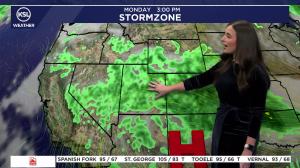Estimated read time: 3-4 minutes
This archived news story is available only for your personal, non-commercial use. Information in the story may be outdated or superseded by additional information. Reading or replaying the story in its archived form does not constitute a republication of the story.
ESCALANTE, Garfield County — Officials at Grand Staircase-Escalante National Monument say a small leak may have spilled more oil and saline water than was initially estimated, contributing to an older spill on the monument.
Hikers discovered an exposed pipeline last month along with the aftermath of a large spill in the Little Valley Wash drainage. Citation Oil and Gas Corp. says the pipe was dug out to patch a "pinhole" leak and had left it exposed to monitor the repair. The Bureau of Land Management was not notified when the leak was discovered because the spill was believed to be less than 10 barrels — the threshold amount lease holders are required to report, according to BLM spokesman Larry Crutchfield.
BLM officials say the vast majority of the oil in the drainage is from a spill that occurred some 30 or 40 years ago. But evidence suggests the more recent spill was larger than initially estimated and could have gone unnoticed for months, according to a news release.
Both leaks originated from well 27, which has a current daily production rate of 17 barrels of oil and 400 barrels of saline water.
"If the pinhole leak was not large enough to shut down the equipment from a loss of pressure, it's possible it leaked more than 10 barrels," Crutchfield said.
Citation did not return calls for comment.
During the investigation, deposits from the older oil spill were also found in Tet Hollow, Horse Spring Canyon, Canaan Wash and Bear Hollow, though they were not affected as extensively as Little Valley Wash, according to the release.
"Our focus is going to be understanding what happened in Little Valley Wash and analyzing the data we've collected, then we'll be able to make decisions on how to best mitigate the damage in other areas," Crutchfield said.
Plants in each area appear to be healthy, though many are still dormant. Officials will better understand how much saline water was lost in the recent leak if plant die-offs occur after dormancy. Water and soil samples being tested will also indicate what implications the spill has for plants and wildlife.
Historical accounts say natural oil seepages occurred in the wash prior to oil extraction, and "the combination of old, recent and perhaps natural seepage makes unraveling the oil deposition history of the area complex," the release states.
BLM geologists plan to map the area to better distinguish what regions have been impacted by each of the two spills on Monday and Tuesday.
While data collection at each site is progressing, BLM officials say the decision to either remove the oil or contain it has yet to be made.
"There are so many variables," Crutchfield said. "The oil deposits are not moving, nor are they having a readily-observable adverse impact on plants and wildlife at the moment. We'll know more when test results are in."







